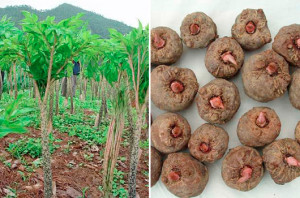Konjac fiber is a starch from the root of the konjac plant (Amorphophallus konjac) that grows in both China and Japan. The popular name for the root in Japan is devil’s tongue or konnyaku, and it is prepared there into foods that look like squares or strips of stiff gelatin, with a rubbery texture.
Contents
Uses
- Used in the same ways as glucomannan.
Benefits
- Konjac root fibers offer many health-promoting benefits through their ability to form a soft gel with water. Health benefit research indicates that soluble fibers such as Glumannan may help lower blood cholesterol, slow glucose absorption, lowers the Glycemic index and promote regular bowel movements. While found in many sources such as fruits, vegetables, oats, and beans, the most-promising soluble fiber may come from Glucomannan. Derived from konjac root, glucomannan has an extraordinary water-holding capacity and is the most viscous of all known dietary fibers.
- Glucomannan offers benefits for those seeking to lose weight. Studies show that supplementing with glucomannan enhances the weight-loss effects of a calorie-restricted diet. Glucomannan may promote weight loss in obese adults, even in the absence of a calorie-restricted diet. When obese adults consumed 1 gram of glucomannan fiber one hour before each meal for eight weeks, they lost an average of 5.5 pounds of body weight—with no other changes to their eating or exercise patterns.
- Glucomannan creates a feeling of satiety or fullness through its water-binding effects. By creating a thick gel, glucomannan delays gastric emptying and slows the release of sugar into the bloodstream, which helps to lower levels of insulin and blood glucose. Additionally, glucomannan improves blood-lipid profiles and can lower systolic blood pressure. Because of these effects, glucomannan can greatly benefit individuals with metabolic syndrome or diabetes.
Cautions
- Blockages of Esophagus, Throat or Intestine: The very characteristics that make konjac root attractive for weight-loss applications in rare circumstances can cause potentially life-threatening blockages of the esophagus, throat or intestine. Glucomannan absorbs large quantities of water, helping to give weight-loss candidates a feeling of fullness and thus reducing their appetite for more food. If the fiber becomes lodged in the esophagus before it reaches the stomach, its intended destination, then it can become a choking hazard, particularly as it swells with any liquid it may pick up.
- Gastrointestinal Distress: Far less dangerous but annoying nonetheless, glucomannan can cause a variety of gastrointestinal complaints, including diarrhea, loose stools and flatulence. Those who experience such symptoms usually can find relief by reducing the amount of glucomannan they are taking. If, however, gastrointestinal discomfort should persist, users should discontinue use of the fiber altogether and consult their doctors.
- Potential for Interaction: Several studies indicate that glucomannan slows or reduces the body’s absorption of both cholesterol and glucose. In a study published in the October 2008 issue of the American Journal of Clinical Nutrition, Connecticut researchers found that glucomannan supplements lowered levels of both total cholesterol and low-density lipoprotein, the so-called bad cholesterol. An earlier study by researchers in Taiwan, published in a 2003 issue of the Journal of the American College of Nutrition, concluded that glucomannan supplements lowered blood glucose levels of patients with type 2 diabetes.
Interactions
- Please check http://nutrawiki.org/glucomannan/
Other names
Amorphophallus konjac, Amorphophallus rivieri, Glucomanano, Glucomannane, Konjac, Konjac Mannan, Konnyaku
References
Source: Cellhealthmakeover, http://www.cellhealthmakeover.com/glucomannan-konjac-root-fiber.html
drweil.com, http://www.drweil.com/drw/u/QAA288742/Can-Konjac-Fiber-Lower-Cholesterol.html

